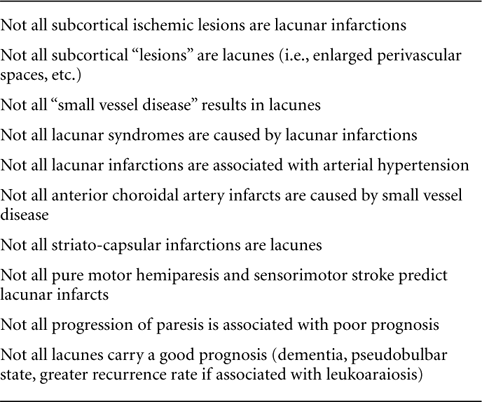Is Lacunar Stroke Dangerous

Age vascular risk factors high nocturnal blood pressure and severity of cerebral small-vessel disease at onset have significant prognostic implications for almost all outcomes.
Is lacunar stroke dangerous. These are very dangerous strokes to have occur because of the blood inside the brain inside the skull can be lethal. If they do death may occur long after the stroke making autopsy material scant and difficult to interpret and the small cerebral vessels require meticulous dis-section. Although recurrence rates and mortality tend to be low in lacunar stroke aspirin is recommended when not contraindicated.
Studies of risk factors and causation have predominantly used a. These arteries are small and are uniquely vulnerable. A lacunar stroke occurs when one of the arteries that provide blood to the brains deep structures is blocked.
Other management strategies include avoidance of hypotension maintenance of euglycemia and measures to decrease the risk of aspiration. According to the National Institutes of Health NIH lacunar strokes represent about one-fifth of all strokes. In some cases the damage is such that the patient finds it difficult to care for self and needs assistance from other people for performing tasks.
Lacunar strokes which account for about one-fifth of all strokes are those that occur in small arteries deep inside the brain. Firstly few patients die from lacunar stroke. In our series the majority of first recurrent strokes were also lacunar infarcts.
As their name implies pure sensory lacunar strokes are strokes in which the only symptoms are sensory abnormalities such as numbness or unusual perception of pain temperature or pressure. Experiencing a lacunar stroke increases your risk of future strokes. The risk of recurrent stroke after lacunar infarct is similar to that for most other types of stroke and patients have an increased risk of developing cognitive decline and dementia.
High blood pressure hypertension can lead to lacunar strokes. LACUNAR STROKE Several factors have hampered the study of lacunar stroke. Um but fortunately this is a type of stroke that actually is becoming less and less common because were doing such a.

Other management strategies include avoidance of hypotension maintenance of euglycemia and measures to decrease the risk of aspiration.
Is lacunar stroke dangerous. If they do death may occur long after the stroke making autopsy material scant and difficult to interpret and the small cerebral vessels require meticulous dis-section. Conclusions Our study confirms that lacunar infarcts are associated with low stroke recurrence and mortality rates. In our series the majority of first recurrent strokes were also lacunar infarcts.
These are very dangerous strokes to have occur because of the blood inside the brain inside the skull can be lethal. In some cases the damage is such that the patient finds it difficult to care for self and needs assistance from other people for performing tasks. Any type of stroke is dangerous because brain cells are deprived of.
As there is some amount of damage bound to happen due to Lacunar Infarct the recovery of the patient depends on the amount of damage that has been done to the brain. In our series the majority of first recurrent strokes were also lacunar infarcts. Lacunar strokes which account for about one-fifth of all strokes are those that occur in small arteries deep inside the brain.
Experiencing a lacunar stroke increases your risk of future strokes. Unlike most arteries which gradually taper to a smaller size the small arteries of a lacunar stroke branch directly off of a large high-pressure heavily muscled main artery. Although recurrence rates and mortality tend to be low in lacunar stroke aspirin is recommended when not contraindicated.
The risk of recurrent stroke after lacunar infarct is similar to that for most other types of stroke and patients have an increased risk of developing cognitive decline and dementia. Firstly few patients die from lacunar stroke. According to the National Institutes of Health NIH lacunar strokes represent about one-fifth of all strokes.
Lacunar stroke is a type of ischemic stroke that occurs within the deepest structures of the brain. As their name implies pure sensory lacunar strokes are strokes in which the only symptoms are sensory abnormalities such as numbness or unusual perception of pain temperature or pressure. These arteries are small and are uniquely vulnerable.

3 The overwhelming majority of pure sensory lacunar strokes affect a brain area called the thalamus an area that is heavily involved in processing the senses from all over the body.
Is lacunar stroke dangerous. The risk of recurrent stroke after lacunar infarct is similar to that for most other types of stroke and patients have an increased risk of developing cognitive decline and dementia. In our series the majority of first recurrent strokes were also lacunar infarcts. Although recurrence rates and mortality tend to be low in lacunar stroke aspirin is recommended when not contraindicated.
As their name implies pure sensory lacunar strokes are strokes in which the only symptoms are sensory abnormalities such as numbness or unusual perception of pain temperature or pressure. Keeping this in view is lacunar stroke dangerous. As there is some amount of damage bound to happen due to Lacunar Infarct the recovery of the patient depends on the amount of damage that has been done to the brain.
Um but fortunately this is a type of stroke that actually is becoming less and less common because were doing such a. These are very dangerous strokes to have occur because of the blood inside the brain inside the skull can be lethal. A lacunar stroke occurs when one of the arteries that provide blood to the brains deep structures is blocked.
According to the National Institutes of Health NIH lacunar strokes represent about one-fifth of all strokes. Lacunar strokes which account for about one-fifth of all strokes are those that occur in small arteries deep inside the brain. Firstly few patients die from lacunar stroke.
If they do death may occur long after the stroke making autopsy material scant and difficult to interpret and the small cerebral vessels require meticulous dis-section. LACUNAR STROKE Several factors have hampered the study of lacunar stroke. High blood pressure hypertension can lead to lacunar strokes.
Conclusions Our study confirms that lacunar infarcts are associated with low stroke recurrence and mortality rates. Any type of stroke is dangerous because brain cells are deprived of. These arteries are small and are uniquely vulnerable.









